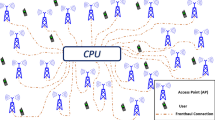Abstract
Channel estimation techniques for CDMA system need to combat multiple access interference (MAI) to improve the estimation performance. The linear MMSE detector has certain advantages with respect to the near–far problem and can be used to develop a channel estimation algorithm. In this paper, an efficient iterative method for near–far resistant single-user mobile radio channel estimation in slow fading multi-path direct sequence code division multiple access (DS-CDMA) channels is presented. Computer simulation results demonstrate that a significant performance improvement can be achieved with the proposed method especially under extreme near–far conditions.
Similar content being viewed by others

References
Bensley S.E., Aazhang B. (1998) Maximum-likelihood synchronization of a single user for code-division multiple-access communication systems. IEEE Transactions on Communications 46(3): 392–399
Grant, S. J.,& Cavers, J. K.(1999). Multiuser channel estimation for detection of cochannel signals. In Proceedings of the IEEE International Conference on Communication.
Haykin S. (1991) Adaptive filter theory (2nd ed). Prentice-Hall, Englewood Cliffs, NJ
Latva-aho M., Juntti J.J. (2000) LMMSE detection for DS-CDMA systems in fading channels. IEEE Transactions on Communications 48(2): 194–199
Missiroli M., Guo Y.J., Barton S.K. (2000) Near-far resistant channel estimation for CDMA systems using the linear decorrelating detector. IEEE Transactions on Communications 48(3): 514–524
Verdu S. (1998) Multiuser detection. Cambridge University Press, Cambridge, New York
Author information
Authors and Affiliations
Corresponding author
Rights and permissions
About this article
Cite this article
Rizaner, A., Amca, H., Hacıoğlu, K. et al. Iterative near–far resistant channel estimation by using a linear minimum mean squared error detector. Wireless Pers Commun 42, 537–542 (2007). https://doi.org/10.1007/s11277-006-9209-4
Received:
Accepted:
Published:
Issue Date:
DOI: https://doi.org/10.1007/s11277-006-9209-4



